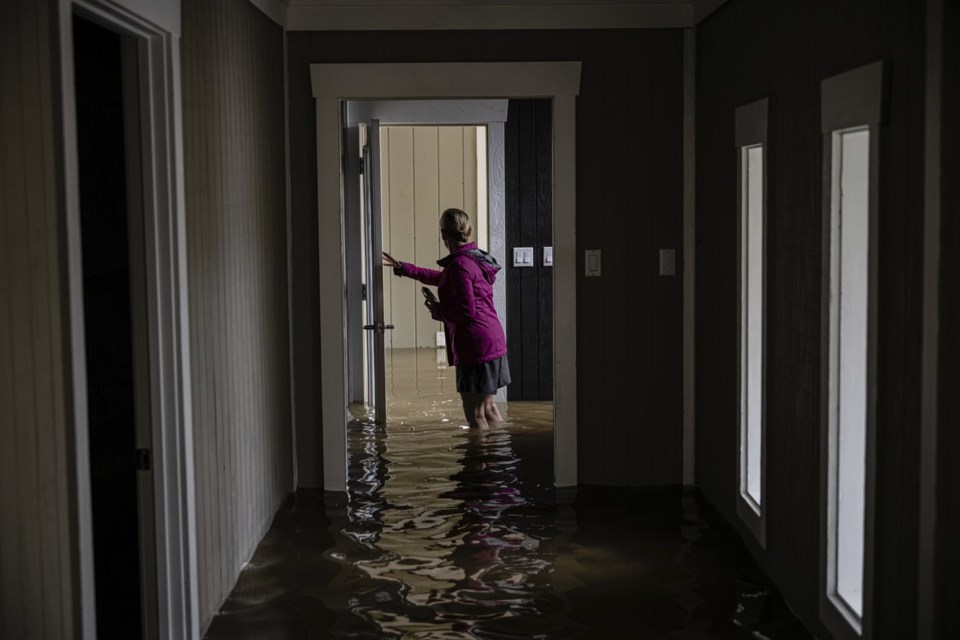DYERSBURG, Tennessee. (AP) — Another round of torrential rain and flash flooding came Saturday for parts of the South and Midwest already heavily waterlogged by days of severe storms that also spawned some deadly tornadoes.
Day after day of heavy rains have pounded the central U.S., rapidly swelling waterways and prompting a series of flash flood emergencies in Missouri, Texas and Arkansas. The National Weather Service said 45 river locations in multiple states were expected to reach major flood stage, with extensive flooding of structures, roads, bridges and other critical infrastructure possible.
At least seven people were killed as the tornadoes destroyed entire neighborhoods, with more twisters possible in places this weekend. Flooding killed at least two more in Kentucky -- 9-year-old boy swept away Friday on his way to school, and a 74-year-old whose body was found Saturday inside a fully submerged vehicle in Nelson County, authorities said.
And interstate commerce is affected — the extreme flooding across a corridor that includes the major cargo hubs in Louisville, Kentucky and Memphis could lead to shipping and supply chain delays, said Jonathan Porter, chief meteorologist at AccuWeather.
The outburst comes at a time when nearly half of NWS forecast offices have 20% vacancy rates after Trump administration job cuts — twice that of just a decade ago.
Louisville Mayor Craig Greenberg said Saturday that the Ohio River had risen five feet in 24 hours and would continue to swell for days.
“We expect this to be one of the top 10 flooding events in Louisville history,” he said.
Flash flood threat looms over many states
Flash flood emergencies continued to be issued Saturday across Arkansas, Mississippi and Tennessee, with more heavy rains and damaging winds in the mix.
Hundreds of Kentucky roads were impassable Friday because of floodwaters, downed trees or mud and rock slides, and the number of closures were likely to increase with more rain Saturday, said Kentucky Gov. Andy Beshear.
Downtown Hopkinsville, Kentucky, reopened early Saturday after floodwaters from the Little River receded, giving a much needed reprieve, but still more rainfall was on its way Saturday and Sunday, Mayor James R. Knight Jr. said.
“We got a little rain but most of it went north of us,” Knight said Saturday. “Thank goodness on that. Gave us a little break.”
Flash flooding is particularly worrisome in rural Kentucky where water can rush off the mountains into the hollows. Less than four years ago, dozens died in flooding in the eastern part of the state.
In north central Kentucky, emergency officials ordered a mandatory evacuation for Falmouth, a town of 2,000 people in a bend of the swelling Licking River, as the rising water summoned fears of damaging floods. The warnings were similar to catastrophic flooding nearly 30 years prior when the river reached a record 50 feet high, resulting in five deaths and 1,000 homes destroyed.
Over in Arkansas, weather officials pleaded with the public to avoid all travel unless absolutely necessary due to the widespread flooding.
On Saturday, BNSF confirmed that a railroad bridge in Mammoth Spring was washed out by floodwaters that caused the derailment of several cars. No injuries were reported, but BNSF had no immediate estimate when the bridge would reopen.
Why so much nasty weather?
Since Wednesday, more than a foot of rain — or 30.5 centimeters — has now fallen in parts of Kentucky, and more than 8 inches (20 centimeters) has fallen in parts of Arkansas and Missouri, forecasters said Saturday.
Forecasters attributed the violent weather to warm temperatures, an unstable atmosphere, strong wind shear and abundant moisture streaming from the Gulf.
At least two reports of observed tornadoes were noted Friday evening in Missouri and Arkansas, according to the NWS. One, near Blytheville, Arkansas, lofted debris at least 25,000 feet (7.6 kilometers) high, according to weather service meteorologist Chelly Amin. The state’s emergency management office reported damage in 22 counties from tornadoes, wind, hail and flash flooding.
Tennessee Gov. Bill Lee said entire neighborhoods in the town of Selmer were “completely wiped out” by a tornado with winds estimated by the NWS of up to 160 mph (257 kph).
On Saturday, dozens of people in Dyersburg, Tennessee, arrived at a storm shelter near a public school in the rain with blankets, pillows and folding chairs.
George Manns, 77, said he was in his apartment when he heard the tornado warning and decided to head to the shelter. Just days earlier, the city was hit by a tornado and caused millions of dollars in damage.
“I grabbed all my stuff and came here,” Mann said, who brought a folding chair and two bags of toiletries, laptops, iPads and his medications. “I don’t leave them in my apartment in case my apartment is destroyed. I have to make sure I have them with me.”
___
Schreiner reported from Shelbyville, Kentucky. Associated Press writers Andrew DeMillo in Little Rock, Arkansas; Jonathan Mattise and Kimberlee Kruesi in Nashville, Tennessee; Adrian Sainz in Memphis, Tennessee; Jeff Martin in Marietta, Georgia; John Raby in Charleston, West Virginia; and Hallie Golden in Seattle contributed.
Bruce Schreiner And Obed Lamy, The Associated Press



